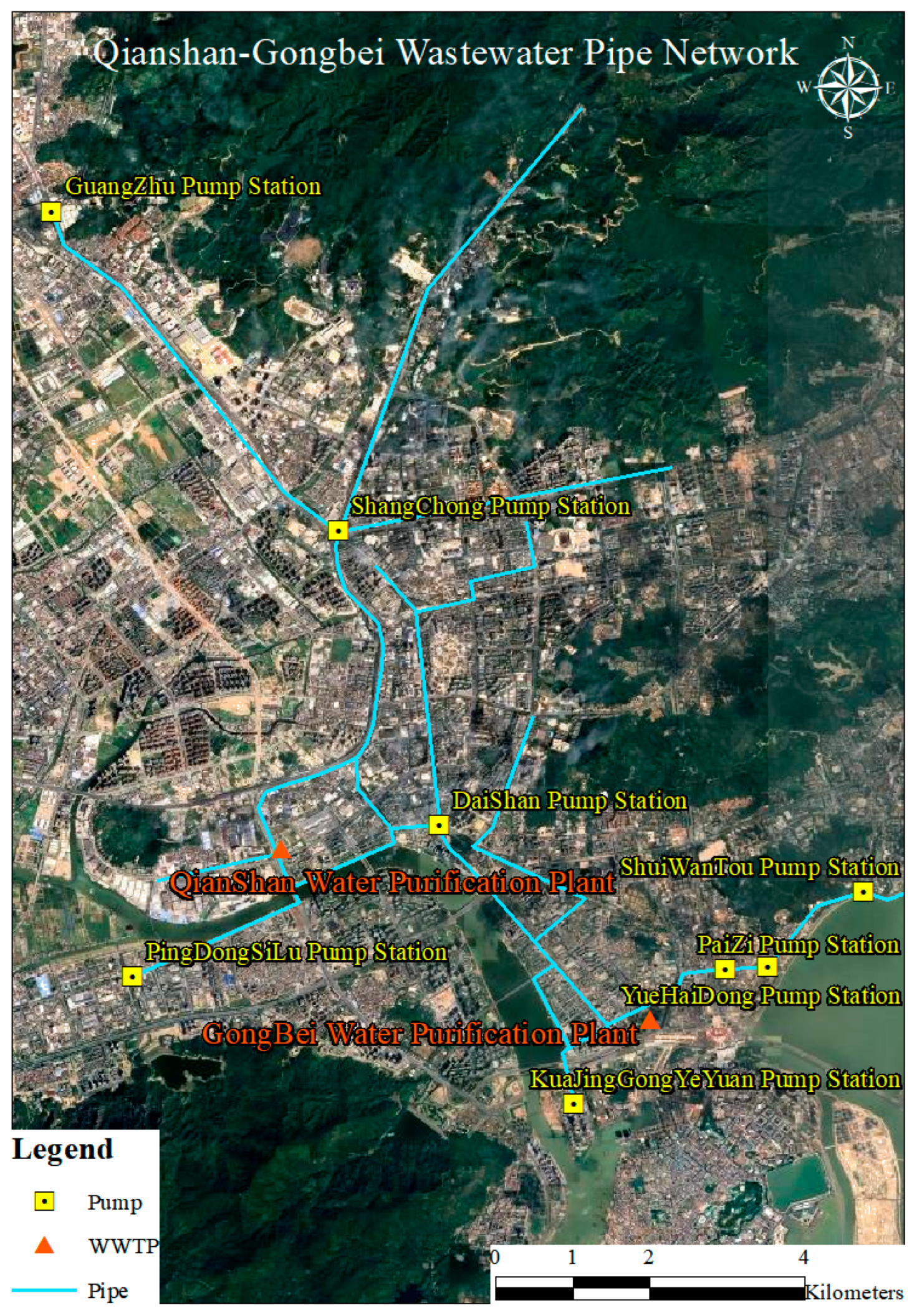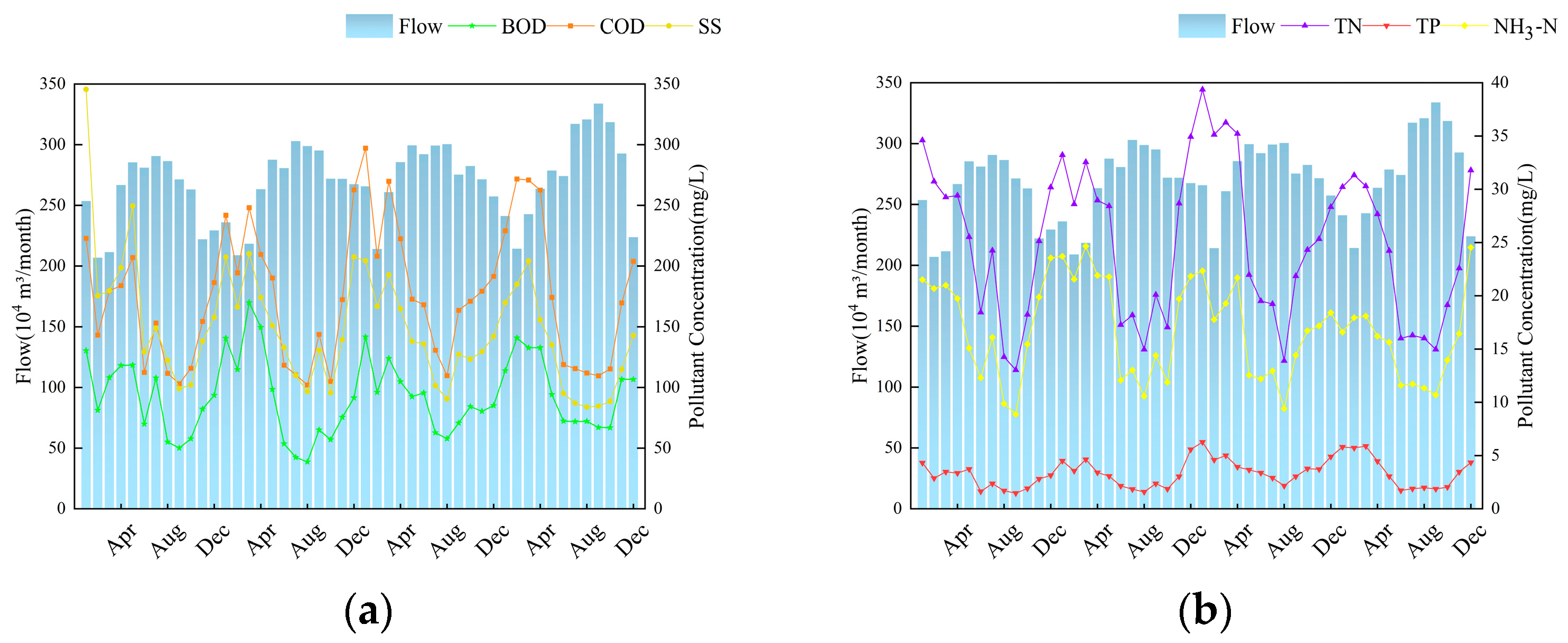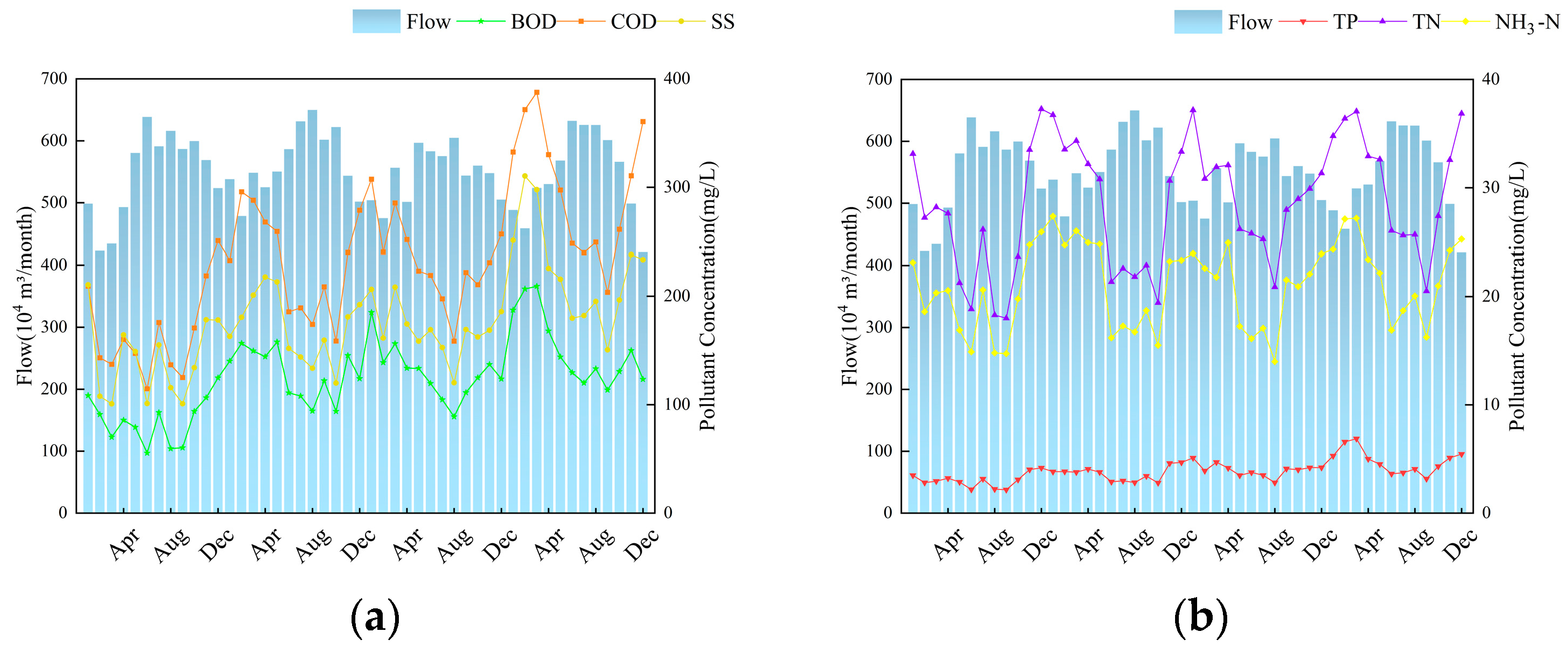Quantitative Assessment of Seasonal and Land-Use Impacts on Coastal Urban Sewage Systems with Seawater Intrusion Vulnerability Analysis
Abstract
1. Introduction
- (i)
- Predicting seawater intrusion impacts on influent quality and WWTP operational efficiency.
- (ii)
- Optimizing pump scheduling to mitigate tidal back-flow effects.
- (iii)
- Forecasting contaminant load variations under compound rainfall-tide scenarios.
- (i)
- Dynamic correlations between tidal cycles and influent salinity fluctuations.
- (ii)
- Nonlinear responses of biological treatment units to variable water quality gradients.
- (iii)
- Capacity allocation strategies under hydraulic and pollution load shocks.
2. Materials and Methods
2.1. Study Area
2.2. Data Sources
2.3. Water Quality Analysis
3. Results
3.1. Seasonal Variations in Influent Quantity and Quality at the Qianshan WWTP
3.2. Seasonal Variations in Influent Quantity and Quality at the Gongbei WWTP
3.3. Impact of Land Use Types on Water Quality and Quantity
3.4. Analysis of Factors Influencing Wastewater Quality in Coastal Pumping Stations
4. Discussion
4.1. Implications of Seasonal Variability
4.2. Influence of Land Use on Sewage Characteristics
4.3. Managing Seawater Intrusion
5. Conclusions
Author Contributions
Funding
Data Availability Statement
Acknowledgments
Conflicts of Interest
Abbreviations
| BOD5 | The 5-day Biochemical Oxygen Demand |
| Cl− | Chloride Ion |
| C:N:P | Carbon-to-Nitrogen-Phosphorus Ratio |
| COD | Chemical Oxygen Demand |
| DPD | N,N-Diethyl-p-Phenylenediamine |
| I/I | Inflow and Infiltration |
| IQR | Interquartile Ranges |
| MDPI | Multidisciplinary Digital Publishing Institute |
| NH3-N | Ammonia Nitrogen |
| PCA | Principal Component Analysis |
| SS | Suspended Solids |
| TN | Total Nitrogen |
| TP | Total Phosphorus |
| WWTP | Wastewater Treatment Plant |
References
- Wang, J.; Liu, G.H.; Wang, J.Y.; Xu, X.L.; Shao, Y.T.; Zhang, Q.; Liu, Y.C.; Qi, L.; Wang, H.C. Current status, existent problems, and coping strategy of urban drainage pipeline network in China. Environ. Sci. Pollut. Res. 2021, 28, 43035–43049. [Google Scholar] [CrossRef] [PubMed]
- Yang, F.L.; Zhang, X.Z.; Li, J.H.; Zhou, B.X. Reduction of pollution loads based on sewage treatment projects around a lake: A case study on Erhai Lake. Water Sci. Technol. 2023, 88, 814–828. [Google Scholar] [CrossRef] [PubMed]
- Zhang, M.; Peng, Y.; Zhang, J.; Wang, C.; Wang, S.; Zeng, W. Effect of influent C/N ratios on denitrifying phosphorus removal characteristics in the A~2/O-BCO process. China Environ. Sci. 2016, 36, 1366–1375. [Google Scholar]
- Szelag, B.; Mehrani, M.J.; Drewnowski, J.; Majewska, M.; Lagód, G.; Kumari, S.; Bux, F. Assessment of wastewater quality indicators for wastewater treatment influent using an advanced logistic regression model. Desalin. Water Treat. 2020, 232, 421–432. [Google Scholar] [CrossRef]
- Wirahadikusumah, R.; Abraham, D.; Iseley, T. Challenging issues in modeling deterioration of combined sewers. J. Infrastruct. Syst. 2001, 7, 77–84. [Google Scholar] [CrossRef]
- Hahn, M.A.; Palmer, R.N.; Merrill, M.S.; Lukas, A.B. Expert system for prioritizing the inspection of sewers: Knowledge base formulation and evaluation. J. Water Resour. Plan. Manag. 2002, 128, 121–129. [Google Scholar] [CrossRef]
- Bizer, M.; Kirchhoff, C.J. Regression modeling of combined sewer overflows to assess system performance. Water Sci. Technol. 2022, 86, 2848–2860. [Google Scholar] [CrossRef]
- Al Aukidy, M.; Verlicchi, P. Contributions of combined sewer overflows and treated effluents to the bacterial load released into a coastal area. Sci. Total Environ. 2017, 607, 483–496. [Google Scholar] [CrossRef]
- Owolabi, T.A.; Mohandes, S.R.; Zayed, T. Investigating the impact of sewer overflow on the environment: A comprehensive literature review paper. J. Environ. Manag. 2022, 301, 113810. [Google Scholar] [CrossRef]
- Soriano, L.; Rubió, J. Impacts of Combined Sewer Overflows on surface water bodies. The case study of the Ebro River in Zaragoza city. J. Clean. Prod. 2019, 226, 1–5. [Google Scholar] [CrossRef]
- Vivekanandan, B.; Jeyannathann, K.; Rao, A.S. Sensitivity of Effluent Variables in Activated Sludge Process. Chem. Prod. Process Model. 2018, 13, 20170010–20170028. [Google Scholar] [CrossRef]
- Rajaei, M.; Nazif, S. Improving wastewater treatment plant performance based on effluent quality, operational costs, and reliability using control strategies for water and sludge lines. Process Saf. Environ. Prot. 2022, 167, 398–411. [Google Scholar] [CrossRef]
- Bogdan, L.; Petriczek, G.; Studzinski, J. An Approach for Planning and Analysis of the Sewage Sanitary Networks Using Some Calculation Formulas and Computer Simulation. In Proceedings of the 9th International Conference on Dependability and Complex Systems (DepCoS-RELCOMEX), Brunow, Poland, 30 June–4 July 2014; pp. 103–113. [Google Scholar]
- Martin, C.; Kamara, O.; Berzosa, I.; Badiola, J.L. Smart GIS platform that facilitates the digitalization of the integrated urban drainage system. Environ. Model. Softw. 2020, 123, 104568. [Google Scholar] [CrossRef]
- Mikovits, C.; Rauch, W.; Kleidorfer, M. Importance of scenario analysis in urban development for urban water infrastructure planning and management. Comput. Environ. Urban Syst. 2018, 68, 9–16. [Google Scholar] [CrossRef]
- Simone, A.; Cesaro, A.; Del Giudice, G.; Di Cristo, C.; Fecarotta, O. Potentialities of Complex Network Theory Tools for Urban Drainage Networks Analysis. Water Resour. Res. 2022, 58, e2022WR032277. [Google Scholar] [CrossRef]
- Huang, X.; Fu, X.; Zhao, Z.; Yin, H. Evaluation of collection efficiency of sewer network based on water quality zoning monitoring. Water Resour. Prot. 2023, 39, 152–159. [Google Scholar]
- Warren, C.; Mackay, D.; Whelan, M.; Fox, K. Mass balance modelling of contaminants in river basins: Application of the flexible matrix approach. Chemosphere 2007, 68, 1232–1244. [Google Scholar] [CrossRef]
- Staufer, P.; Scheidegger, A.; Rieckermann, J. Assessing the performance of sewer rehabilitation on the reduction of infiltration and inflow. Water Res. 2012, 46, 5185–5196. [Google Scholar] [CrossRef]
- Montoya-Coronado, V.A.; Tedoldi, D.; Castebrunet, H.; Molle, P.; Kouyi, G.L. Data-driven methodological approach for modeling rainfall-induced infiltration effects on combined sewer overflow in urban catchments. J. Hydrol. 2024, 632, 130834. [Google Scholar] [CrossRef]
- Administration TSEP. Water and Wastewater Monitoring and Analysis Method, 4th ed.; China Environmental Science Press: Beiiing, China, 2002. [Google Scholar]
- Administration SEP. Water Quality Determination of the Chemical Oxygen Demand Fast Digestion-Spectrophotometric Method; China Environmental Science Press: Beijing, China, 2007. [Google Scholar]
- Administration SEP. Water Quality-Determination of Biochemical Oxygen Demand After 5 Days(BODs) for Dilution and Seeding Method; China Environmental Science Press: Beijing, China, 2009. [Google Scholar]
- Administration SEP. Water Quality-Determination o Suspended Substance-Gravimetric Method; China Environmental Science Press: Beiiing, China, 1990. [Google Scholar]
- Administration SEP. Water Quality-Determination of Total Nitrogen-Alkalinepotassium Persulfate Digestion UV Spectrophotometric Method; China Environmental Science Press: Beiiing, China, 2012. [Google Scholar]
- Administration SEP. Water Quality-Determination of Total Phosphorus Ammonium Molybdate Spectrophotometrie Method; China Environmental Science Press: Beiiing, China, 1990. [Google Scholar]
- Administration SEP. Water Quality Determination of Ammonia Nitrogen Nessler’s Reagent Spectrophotometry; China Environmental Science Press: Beiiing, China, 2010. [Google Scholar]
- Moberg, L.; Karlberg, B. An improved N,N′-diethyl-p-phenylenediamine (DPD) method for the determination of free chlorine based on multiple wavelength detection. Anal. Chim. Acta 2000, 407, 127–133. [Google Scholar] [CrossRef]
- Schwenke, K.U.; Spiehl, D.; Krausse, M.; Riedler, L.; Ruppenthal, A.; Villforth, K.; Meckel, T.; Biesalski, M.; Rupprecht, D.; Schwall, G. Analysis of free chlorine in aqueous solution at very low concentration with lateral flow tests. Sci. Rep. 2019, 9, 17212. [Google Scholar] [CrossRef] [PubMed]
- Jurik, L.; Kaletova, T.; Sedmakova, M.; Balazova, P.; Cervenanska, A. Comparison of Service Characteristics of Two Town’s Wwtp. J. Ecol. Eng. 2017, 18, 61–67. [Google Scholar] [CrossRef][Green Version]
- Yuan, S.X.; Huang, G.Q.; Chen, W.Y.; Chen, Z.H.; Yin, X.L. Study on Relationship between Seasonal Temperatures and Municipal Wastewater Pollutant Concentration and Removal Rate. In Proceedings of the 3th International Conference on Industrial Engineering and Applications (ICIEA), Hong Kong, China, 28–30 April 2016. [Google Scholar]
- Jiang, A.Z.; McBean, E.A.; Binns, A.; Gharabaghi, B. Quantifying Rainfall-Derived Inflow from Private Foundation Drains in Sanitary Sewers: Case Study in London, Ontario, Canada. J. Hydrol. Eng. 2019, 24. [Google Scholar] [CrossRef]
- Cahoon, L.B.; Hanke, M.H. Inflow and infiltration in coastal wastewater collection systems: Effects of rainfall, temperature, and sea level. Water Environ. Res. 2019, 91, 322–331. [Google Scholar] [CrossRef] [PubMed]
- Yap, H.T.; Ngien, S.K. Assessment on inflow and infiltration in sewerage systems of Kuantan, Pahang. Water Sci. Technol. 2017, 76, 2918–2927. [Google Scholar] [CrossRef]
- Zeydalinejad, N.; Javadi, A.A.; Webber, J.L. Global perspectives on groundwater infiltration to sewer networks: A threat to urban sustainability. Water Res. 2024, 262, 122098. [Google Scholar] [CrossRef] [PubMed]
- Mohrlok, U.; Wolf, L.; Klinger, J. Quantification of infiltration processes in urban areas by accounting for spatial parameter variability. J. Soils Sediments 2008, 8, 34–42. [Google Scholar] [CrossRef]
- Zhang, K.; Parolari, A.J. Impact of stormwater infiltration on rainfall-derived inflow and infiltration: A physically based surface-subsurface urban hydrologic model. J. Hydrol. 2022, 610, 127938. [Google Scholar] [CrossRef]
- Bonneau, J.; Fletcher, T.D.; Costelloe, J.F.; Poelsma, P.J.; James, R.B.; Burns, M.J. Where does infiltrated stormwater go? Interactions with vegetation and subsurface anthropogenic features. J. Hydrol. 2018, 567, 121–132. [Google Scholar] [CrossRef]
- Dirckx, G.; Fenu, A.; Wambecq, T.; Kroll, S.; Weemaes, M. Dilution of sewage: Is it, after all, really worth the bother? J. Hydrol. 2019, 571, 437–447. [Google Scholar] [CrossRef]
- Flood, J.F.; Cahoon, L.B. Risks to Coastal Wastewater Collection Systems from Sea-Level Rise and Climate Change. J. Coast. Res. 2011, 27, 652–660. [Google Scholar] [CrossRef]
- Rashid, S.S.; Liu, Y.Q. Assessing environmental impacts of large centralized wastewater treatment plants with combined or separate sewer systems in dry/wet seasons by using LCA. Environ. Sci. Pollut. Res. 2020, 27, 15674–15690. [Google Scholar] [CrossRef] [PubMed]
- Thabrez, M.; Parimalarenganayaki, S. Assessment of Hydrogeochemical Characteristics and Seawater Intrusion in Coastal Parts of Mangaluru City, Karnataka, India. Water Air Soil Pollut. 2023, 234, 251. [Google Scholar] [CrossRef]
- Hussain, M.S.; Abd-Elhamid, H.F.; Javadi, A.A.; Sherif, M.M. Management of Seawater Intrusion in Coastal Aquifers: A Review. Water 2019, 11, 2467. [Google Scholar] [CrossRef]
- Wang, Z.Y.; Wang, S.; Liu, W.Y.; Su, Q.; Tong, H.; Xu, X.Y.; Gao, Z.J.; Liu, J.T. Hydrochemical Characteristics and Irrigation Suitability Evaluation of Groundwater with Different Degrees of Seawater Intrusion. Water 2020, 12, 3460. [Google Scholar] [CrossRef]
- Miranda, C.; Castro, P.M.L.; Amorim, C.L. Stable nutrient removal from wastewater with fluctuating seawater content ensured by an adaptable aerobic granular sludge microbiome. Waste Manag. Bull. 2024, 2, 145–154. [Google Scholar] [CrossRef]
- Zain, Z.M.; Munaaim, M.A.C.; Mat-Noh, M. Solar powered microcontroller module for real-time sewerage treatment plant monitoring system: Prototype development. In Proceedings of the 2017 7th IEEE International Conference on System Engineering and Technology (ICSET) Proceedings, Shah Alam, Malaysia, 2–3 October 2017; pp. 177–182. [Google Scholar] [CrossRef]
- Sonnenschein, B.; Ziel, F. Probabilistic Intraday Wastewater Treatment Plant Inflow Forecast Utilizing Rain Forecast Data and Sewer Network Sensor Data. Water Resour. Res. 2023, 59, e2022WR033826. [Google Scholar] [CrossRef]
- Youssef, S.; Nachabe, M. Rehabilitation Technologies to Abate Infiltration in Sanitary Sewers. J. Environ. Eng. 2023, 149, 04023025. [Google Scholar] [CrossRef]
- Karamoutsou, L.; Veliou, E.; Kvernberg, E.B.; Psilovikos, A. Urban Stormwater Management: A Sustainable Approach. Water 2024, 16, 2089. [Google Scholar] [CrossRef]
- Choi, Y.Y.; Baek, S.R.; Kim, J.I.; Choi, J.W.; Hur, J.; Lee, T.U.; Park, C.J.; Lee, B.J. Characteristics and Biodegradability of Wastewater Organic Matter in Municipal Wastewater Treatment Plants Collecting Domestic Wastewater and Industrial Discharge. Water 2017, 9, 409. [Google Scholar] [CrossRef]
- Jahromi, A.F.; Elektorowicz, M. Modified electrochemical processes for industrial-scale treatment of wastewater having high TKN content. Electrochim. Acta 2020, 354, 136724. [Google Scholar] [CrossRef]
- Wen, G.H.; Yang, L.W.; Zhang, X.Y.; Zhou, Y.; Zhou, H.; Hu, X.H. The Impact of Environmental Regulation on Farmland Non-Point Source Pollution: Evidence from the Dongting Lake Plain, China. Sustainability 2025, 17, 328. [Google Scholar] [CrossRef]
- Qian, Y.; Sun, L.; Chen, D.K.; Liao, J.F.; Tang, L.N.; Sun, Q. The response of the migration of non-point source pollution to land use change in a typical small watershed in a semi-urbanized area. Sci. Total Environ. 2021, 785, 147387. [Google Scholar] [CrossRef]
- Atinkpahoun, C.N.H.; Le, N.D.; Pontvianne, S.; Poirot, H.; Leclerc, J.P.; Pons, M.N.; Soclo, H.H. Population mobility and urban wastewater dynamics. Sci. Total Environ. 2018, 622, 1431–1437. [Google Scholar] [CrossRef]
- Wilson, M.T.; Fischbach, J.R.; Siler-Evans, K.; Tierney, D. Modeling the uncertainty of potential impacts on Robust Stormwater Management from neighborhood-scale impervious cover change: A case study of population-based scenarios in Pittsburgh, Pennsylvania. Urban Water J. 2020, 17, 628–641. [Google Scholar] [CrossRef]
- Suchowska-Kisielewicz, M.; Nowogonski, I. Influence of storms on the emission of pollutants from sewage into waters. Sci. Rep. 2021, 11, 18788. [Google Scholar] [CrossRef]
- Hailegeorgis, T.T.; Alfredsen, K. High spatial-temporal resolution and integrated surface and subsurface precipitation-runoff modelling for a small stormwater catchment. J. Hydrol. 2018, 557, 613–630. [Google Scholar] [CrossRef]
- Ncube, M.M.; Ngulube, P. Enhancing environmental decision-making: A systematic review of data analytics applications in monitoring and management. Discov. Sustain. 2024, 5, 290. [Google Scholar] [CrossRef]
- Mhlanga, F.T.; Brouckaert, C.J. Characterisation of wastewater for modelling of wastewater treatment plants receiving industrial effluent. Water Sa 2013, 39, 403–407. [Google Scholar] [CrossRef]
- Orhon, D.; Hallaç, E.; Solmaz, B.; Ubay-Çokgör, E.; Sözen, S. Impact of rainwater intrusion on wastewater characterization and performance of nutrient removal activated sludge process. J. Chem. Technol. Biotechnol. 2024, 99, 171–182. [Google Scholar] [CrossRef]
- Kuan, W.K.; Jin, G.Q.; Xin, P.; Robinson, C.; Gibbes, B.; Li, L. Tidal influence on seawater intrusion in unconfined coastal aquifers. Water Resour. Res. 2012, 48. [Google Scholar] [CrossRef]
- Alberti, L.; Francani, V.; La Licata, I. Characterization of salt-water intrusion in the lower Esino Valley, Italy using a three-dimensional numerical model. Hydrogeol. J. 2009, 17, 1791–1804. [Google Scholar] [CrossRef]
- Lu, C.S.; Qiu, J.M.; Yang, Y.; Hu, Y.; Li, Y.Y.; Kobayashi, T.; Zhang, Y.J. A review of anaerobic granulation under high-salinity conditions: Mechanisms, influencing factors and enhancement strategies. J. Water Process Eng. 2023, 55, 104227. [Google Scholar] [CrossRef]
- Chen, H.; Wang, Y.Y.; Chen, Z.; Wu, Z.Q.; Chu, X.Y.; Qing, S.Q.; Xu, L.Q.; Yang, K.; Meng, Q.Y.H.; Cheng, H.A.; et al. Effects of salinity on anoxic-oxic system performance, microbial community dynamics and co-occurrence network during treating wastewater. Chem. Eng. J. 2023, 461, 141969. [Google Scholar] [CrossRef]
- Rivera-Araya, J.; Pollender, A.; Huynh, D.; Schlömann, M.; Chávez, R.; Levicán, G. Osmotic Imbalance, Cytoplasm Acidification and Oxidative Stress Induction Support the High Toxicity of Chloride in Acidophilic Bacteria. Front. Microbiol. 2019, 10, 2455. [Google Scholar] [CrossRef]
- Sánchez, O.; Aspé, E.; Martí, M.C.; Roeckel, M. The effect of sodium chloride on the two-step kinetics of the nitrifying process. Water Environ. Res. 2004, 76, 73–80. [Google Scholar] [CrossRef]








Disclaimer/Publisher’s Note: The statements, opinions and data contained in all publications are solely those of the individual author(s) and contributor(s) and not of MDPI and/or the editor(s). MDPI and/or the editor(s) disclaim responsibility for any injury to people or property resulting from any ideas, methods, instructions or products referred to in the content. |
© 2025 by the authors. Licensee MDPI, Basel, Switzerland. This article is an open access article distributed under the terms and conditions of the Creative Commons Attribution (CC BY) license (https://creativecommons.org/licenses/by/4.0/).
Share and Cite
Ge, Y.; Lin, J.; Yin, Q.; Huang, S.; Lin, Y.; He, K. Quantitative Assessment of Seasonal and Land-Use Impacts on Coastal Urban Sewage Systems with Seawater Intrusion Vulnerability Analysis. Water 2025, 17, 1939. https://doi.org/10.3390/w17131939
Ge Y, Lin J, Yin Q, Huang S, Lin Y, He K. Quantitative Assessment of Seasonal and Land-Use Impacts on Coastal Urban Sewage Systems with Seawater Intrusion Vulnerability Analysis. Water. 2025; 17(13):1939. https://doi.org/10.3390/w17131939
Chicago/Turabian StyleGe, Yanhong, Jiachong Lin, Qidong Yin, Sheng Huang, Yingchao Lin, and Kai He. 2025. "Quantitative Assessment of Seasonal and Land-Use Impacts on Coastal Urban Sewage Systems with Seawater Intrusion Vulnerability Analysis" Water 17, no. 13: 1939. https://doi.org/10.3390/w17131939
APA StyleGe, Y., Lin, J., Yin, Q., Huang, S., Lin, Y., & He, K. (2025). Quantitative Assessment of Seasonal and Land-Use Impacts on Coastal Urban Sewage Systems with Seawater Intrusion Vulnerability Analysis. Water, 17(13), 1939. https://doi.org/10.3390/w17131939








